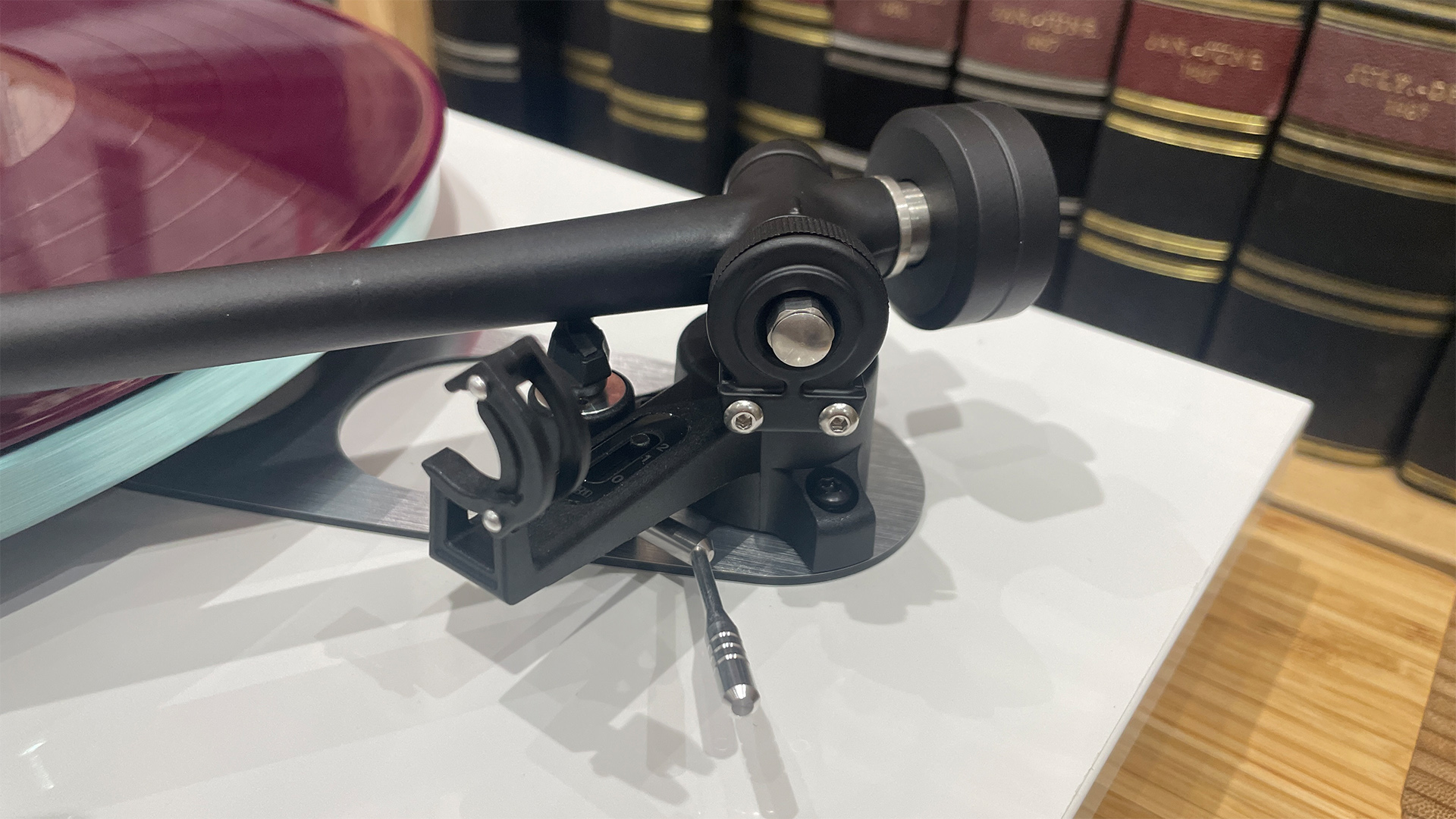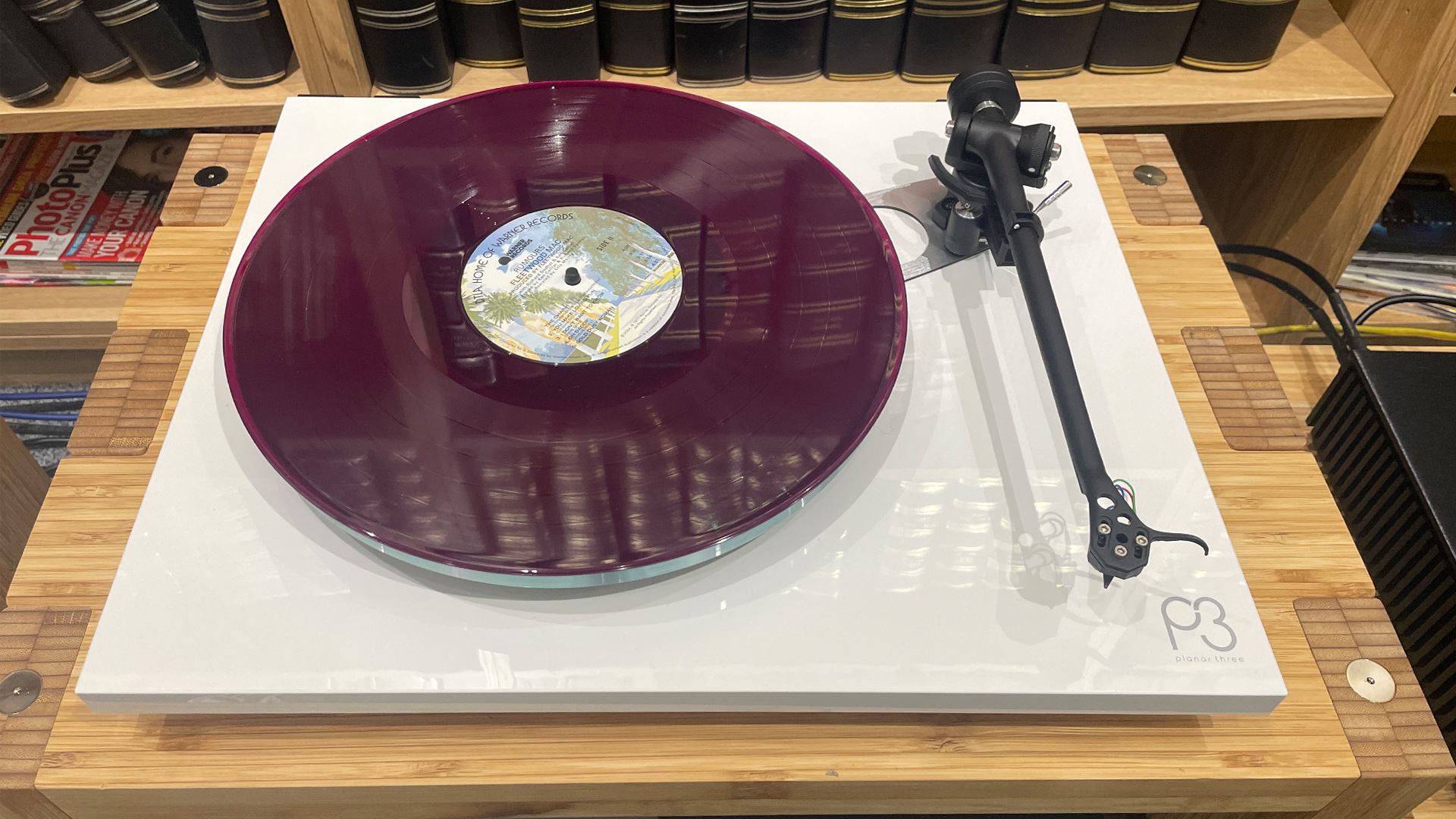
Rega’s Planar 3 turntable was introduced in 1976, the same year What Hi-Fi? was born. Since then it has remained one of our go-to recommendations for sensibly-priced record players. While the deck hasn’t changed much in appearance since then, just about every part of it has been refined at some point. The most significant milestones have been the addition of the legendary RB300 arm in 1983, the change to the still-current low-noise 24v motor in 2007 and the extensive redesign in 2016.
In that 2016 redesign, the light but rigid plinth design continued, but the area between the main bearing and arm was further reinforced by a pair of phenolic resin braces. These added even more stiffness between those critical points without the penalty of significant extra mass. You should know that Rega thinks that structural mass absorbs energy from the music and increases the transmission of unwanted resonances, and so should be minimised where possible. The current RB330 tonearm was introduced at this time and the quality of Planar 3’s finish was improved markedly too.
Build & design

What of the 2024 Planar 3 in front of us? As far as the deck is concerned there is nothing new to report, but that isn’t a great issue when its performance remains class-leading. Its build is impressive as is the quality of the engineering, especially of the fitted RB330 tonearm. The Planar 3 is now available in four finish options: black, white and red, all in gloss, and the recently introduced light oak finish.
We still have to put up with a manual speed change process that involves removing the 12mm thick glass platter and physically shifting the drive belt from one motor pulley step to the next, though. If you want an electronic speed change the optional outboard Neo PSU Mk2 power supply does the job for £260 / $445 / AU$549.

Type Belt drive
Operation Manual
Speeds 33⅓, 45
Speed change Manual
Cartridge Rega Nd3 moving magnet
Phono stage? No
Bluetooth? No
USB? No
Dimensions (hwd) 117 x 447 x 360mm
Weight 6kg
Finishes x 4 (gloss black, gloss white, gloss red, light oak)
The Planar 3 doesn’t offer much more than a trio of rubber feet in terms of isolation, so it makes sense to take care over placement. A light and rigid support positioned well away from the speakers is a great start. Rega makes a dedicated wall shelf, which is ideal if your listening room has a suspended wooden floor as many do in the UK.
While it is important to focus on the deck, it is the main part of this package after all, it’s the change of cartridge from the long-running Elys 2 to the new Nd3 moving magnet that has prompted this review.
The Nd3 is the entry-level model in a new three-strong range. It costs £175 / $345 / AU£380 if bought separately from the Planar 3 (£660 / $1125 / AU$1449), so there is a small saving buying the two together. The next rung up the ladder is the Nd5 (£295 / $675 / AU$650) with the range-topping Nd7 coming in at £450 / $795 / AU$999.

It is possible to buy the Planar 3 fitted with an Nd5, with the difference in package price broadly the same as that between the cartridges. Our focus, however, is on the starter combination, which costs the same as the previous Planar 3/Elys 2 pairing. Given the rate at which prices are going up in the hi-fi industry as a whole, Rega could have easily justified charging more. We are glad it hasn’t.
The Nd cartridge family has been in development for around a decade and Rega believes it is the first to use neodymium in a moving magnet cartridge. This type of magnet material is exceptionally strong, which means that only small amounts are needed. There is a lot of commonality between the models in the range. They share a carefully configured generator assembly that features in-house wound coils and a thoughtfully designed PPS (polyphenylene sulphide) body.

The main point of differentiation between the cartridges comes down to the choice of stylus tip. The Nd3 uses the most basic type, which is elliptical in profile and made of a man-made polycrystalline diamond. Things get increasingly sophisticated with each step up with the Nd7 using the same ‘fine-line’ nude diamond profile as Rega’s high-end moving coil designs. All the cartridges in the range have a recommended tracking weight of 1.75g and produce a healthy output of 5-6mV. No partnering phono stage should take issue with that.
Compatibility

The Nd3, like the company’s other cartridges, uses Rega’s three-point mounting arrangement so that fitting is easy and fuss-free when using any of the company’s tonearms. As with the Planar 3 deck, there is a lifetime warranty against manufacturing faults. That warranty shows the brand’s considerable faith in its build standards.
While not quite plug-and-play, the Planar 3/Nd3 combination isn’t far off. It takes us a matter of minutes to get up and running. We use Naim’s excellent Nait XS3 integrated amplifier plugged into the KEF LS50 Meta standmounts for some of our reviewing sessions but also try the package in our reference system of Cyrus Phono Signature/PSX-R2 phono stage, Burmester 088/ 911 MkIII amplifier and ATC SCM50 speakers to shine a light on its performance. We have a review sample of the previous Planar 3/Elys 2 combination on hand as a benchmark, too.
Sound

As the Planar 3 deck is unchanged, any difference in sound is down to the cartridge. The comparisons between the Nd3 and long-running Elys 2 don’t take long to make. As we work our way through Michael Jackson’s Bad set, The Boatman’s Call by Nick Cave and the Bad Seeds and Beethoven's 9th Symphony, it becomes clear that the new cartridge is better in just about every area. There is an obvious similarity in sonic character, with both cartridges delivering a similar sense of energy and drive. The tonal balance isn’t too different either; both remain pretty well-balanced, though we would hesitate to call either truly neutral.
But look elsewhere and you will notice a significant improvement in terms of detail resolution. The Nd3 tells us more about the recording, rendering vocals and instrumental textures more convincingly. It has stronger dynamics too. The dramatic percussion on Jackson’s Speed Demon comes through with far greater impact on the newcomer while the orchestral peaks on the 9th Symphony are more muscular and authoritative. Stereo imaging is more expansive and notably improved in terms of focus. We find that the Nd3’s high-frequency performance is cleaner and more refined. At the other end of the frequency spectrum, bass is cleaner, deeper and more precise.

Some things haven’t changed much though, and that’s a good thing. This Rega package continues to be a class-leading entertainer. The turntable conveys the rhythmic drive of music superbly, making the most of hard-charging tracks like Smooth Criminal, squeezing the recording for every last drop of excitement and drama. Yet, ask the combination to drop down a gear or two to deliver a passionate but thoughtful love song such as Into My Arms by Nick Cave and it can communicate the music’s gentle but insistent flow with skill.
Voices come through with clarity and brim with expression thanks to a midrange performance that is articulate, fluid and substantial. We have come to associate Rega’s turntables with having a pleasingly cohesive nature to their presentation and that is still the case here. This trait has the benefit of focusing our attention on the music rather than the mechanics of hi-fi replay.
Verdict

All in all, the Planar 3/Nd3 package represents a notable improvement on its predecessor without a jump in price. It is a well-built and engineered turntable that performs to an enviably high standard for the money. Setting it up is a breeze and using it is a pleasure. We have no choice but to recommend it highly.
Review published: August 2024. Review updated: November 2024.
SCORES
- Sound 5
- Build 5
- Features 3
MORE:
Read our review of the Pro-Ject Debut Pro
Also consider the Technics SL-1500C
Best turntables: top record players tested for every budget







